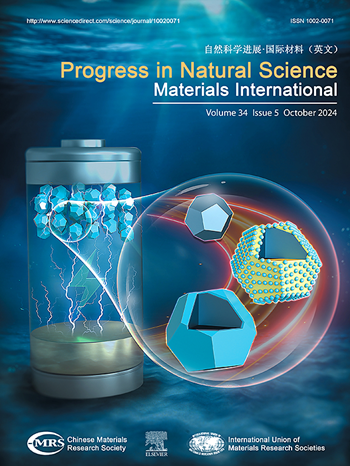Developing aluminum matrix composites through microstructure optimization and particle reinforcement via ARB and cryorolling
IF 7.1
2区 材料科学
Q2 MATERIALS SCIENCE, MULTIDISCIPLINARY
Progress in Natural Science: Materials International
Pub Date : 2025-08-01
DOI:10.1016/j.pnsc.2025.04.004
引用次数: 0
Abstract
Aluminum matrix composites (AMCs) reinforced with titanium carbide (TiC) particles were fabricated through accumulative roll bonding (ARB) and cryorolling. This study explores the effect of ARB temperatures (373 K, 473 K, 623 K, and 723 K) on the dispersion of TiC particles, followed by cryorolling to assess the influence on mechanical properties. This research also focuses on the TiC-Al interface, as its bonding strength plays a significant role in composite performance. Microstructural analyses using SEM, EDS, and TEM revealed that ARB processing at 623 K followed by cryorolling resulted in the most homogeneous TiC distribution and optimal interface bonding, leading to significant improvements in mechanical properties. The study emphasizes the importance of controlling processing temperature and cycles to achieve a uniform dispersion of TiC particles and maintain an effective interface between TiC and the aluminum matrix. While lower ARB temperatures (373 K and 473 K) resulted in particle clustering, higher ARB temperatures (723 K) caused grain coarsening, leading to suboptimal strengthening. This research provides new insights into tailoring processing conditions to enhance both microstructure and mechanical performance of TiC-reinforced AMCs for advanced engineering applications.
通过组织优化和ARB和冷轧强化制备铝基复合材料
采用累积轧制结合和低温轧制的方法制备了碳化钛颗粒增强铝基复合材料(AMCs)。本研究探讨了ARB温度(373 K, 473 K, 623 K和723 K)对TiC颗粒分散的影响,然后进行冷冻轧制以评估其力学性能的影响。TiC-Al界面的结合强度对复合材料的性能起着重要的作用。利用SEM、EDS和TEM进行的显微组织分析表明,在623 K下进行ARB处理,然后进行冷冻轧制,可以获得最均匀的TiC分布和最佳的界面结合,从而显著提高了力学性能。该研究强调了控制加工温度和循环的重要性,以实现TiC颗粒的均匀分散,并保持TiC与铝基体之间的有效界面。较低的ARB温度(373 K和473 K)导致晶粒聚集,较高的ARB温度(723 K)导致晶粒粗化,导致强化效果不理想。该研究为定制加工条件提供了新的见解,以提高tic增强amc的微观结构和力学性能,用于先进的工程应用。
本文章由计算机程序翻译,如有差异,请以英文原文为准。
求助全文
约1分钟内获得全文
求助全文
来源期刊
CiteScore
8.60
自引率
2.10%
发文量
2812
审稿时长
49 days
期刊介绍:
Progress in Natural Science: Materials International provides scientists and engineers throughout the world with a central vehicle for the exchange and dissemination of basic theoretical studies and applied research of advanced materials. The emphasis is placed on original research, both analytical and experimental, which is of permanent interest to engineers and scientists, covering all aspects of new materials and technologies, such as, energy and environmental materials; advanced structural materials; advanced transportation materials, functional and electronic materials; nano-scale and amorphous materials; health and biological materials; materials modeling and simulation; materials characterization; and so on. The latest research achievements and innovative papers in basic theoretical studies and applied research of material science will be carefully selected and promptly reported. Thus, the aim of this Journal is to serve the global materials science and technology community with the latest research findings.
As a service to readers, an international bibliography of recent publications in advanced materials is published bimonthly.

 求助内容:
求助内容: 应助结果提醒方式:
应助结果提醒方式:


